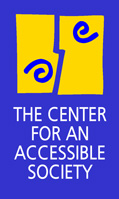
DISABILITY
ISSUES
INFORMATION
FOR
JOURNALISTS
TOPICS
ABOUT
THE CENTER
Americans with disabilities are less than half as likely as their non-disabled counterparts to own a computer, and they are about one-quarter as likely to use the Internet, writes Stephen Kaye, Ph.D. of the Dsability Statistics Center.
Computer technology and the Internet have a tremendous potential to broaden the lives and increase the independence of people with disabilities. Those who have difficulty leaving their homes can now log in and order groceries, shop for appliances, research health questions, participate in online discussions, catch up with friends, or make new ones. Blind people, who used to wait months or years for the information they needed to be made available in Braille or on audiotape, can now access the very same news stories, magazine articles, government reports, and information on consumer products at the very same time it becomes available to the sighted population. People who have difficulty holding a pen or using a keyboard can use the latest speech recognition software to write letters, pay their bills, or perform work-related tasks.
These new technologies hold great promise, but as this report makes abundantly clear, the computer revolution has left the vast majority of people with disabilities behind. Only one-quarter of people with disabilities own computers, and only one-tenth ever make use of the Internet. Elderly people with disabilities, and those with low incomes or low educational attainment, are even less likely to take advantage of these new technologies. African Americans with disabilities also have an especially low rate of computer and Internet use.
More from the Disability Statistics Center.
Overview.